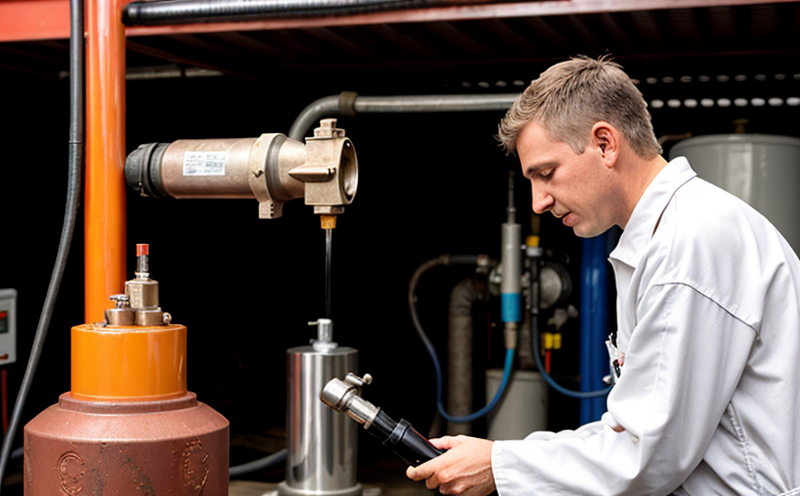ISO 3990 Distillation Characteristics Testing of Aviation Fuels
The ISO 3990 distillation characteristics test is a critical procedure that assesses the boiling point range and vapor pressure of aviation fuels. This test ensures the fuel's ability to evaporate at appropriate temperatures, which is essential for reliable engine performance in various environmental conditions. The test is particularly important in aerospace & aviation testing as it directly influences aircraft safety, efficiency, and compliance with international standards.
The distillation characteristics of aviation fuels are influenced by several factors including the type of fuel (e.g., Jet A-1), impurities present, and the manufacturing process. The test is carried out to ensure that these factors do not compromise the fuel's performance in critical applications. During the distillation process, the fuel sample is heated, and the vapors are collected at various temperatures. This results in a temperature–volume curve known as the distillation curve or boiling point range.
The vapor pressure of aviation fuels also plays a crucial role in their efficiency and safety. High vapor pressures can lead to issues such as excessive volatility during storage, while low vapor pressures may result in difficulties starting engines under cold conditions. The ISO 3990 test helps to determine the vapor pressure at both 10% and 90% points of distillation, which are key indicators for fuel performance.
For compliance with international standards such as ISO 3990, ASTM D7562, and ICAO Annex 14, accurate and reliable testing is essential. These standards provide the framework within which labs must operate to ensure consistent results across different regions and organizations. The test results are used by quality managers and compliance officers to verify that the fuel meets all required specifications.
During the distillation process, the sample is heated in a fractionating column at controlled rates until it has distilled down to 95% of its original volume. The temperature at which specific fractions begin to distill are recorded as key data points. This information helps R&D engineers and procurement teams make informed decisions about fuel specifications and quality control measures.
| Temperature Range (°C) | Fraction | Description |
|---|---|---|
| 20–35 | Vapor Pressure | Indicates the fuel's ability to vaporize under pressure. |
| 41–66 | Initial Boiling Point (IBP) | The lowest temperature at which a small amount of the liquid will distill. |
| 70–85 | 10% Volume Point | Temperature at which 10% of the fuel has distilled off. |
| 92–106 | 90% Volume Point | Temperature at which 90% of the fuel has distilled off. |
| 108–134 | Final Boiling Point (FBP) | The temperature at which 95% of the fuel is distilled down to 5% volume remaining. |
Understanding these key data points allows for precise control over fuel quality and helps in optimizing engine performance. The test results are also used by regulatory bodies to ensure that fuels meet safety standards, thereby enhancing aviation safety.
Why It Matters
The ISO 3990 distillation characteristics testing is pivotal for several reasons within the aerospace & aviation industry:
- Engine Efficiency: Ensures that fuels can vaporize properly to enhance engine efficiency and performance.
- Safety: Guarantees that fuel will not boil over in engines, reducing the risk of fires or other hazards.
- Emissions Compliance: Helps meet stringent international standards regarding emissions from aircraft engines.
- Operational Reliability: Ensures consistent performance across different environmental conditions, which is crucial for global air travel.
Scope and Methodology
The ISO 3990 test follows a standardized protocol to ensure consistency in results. The method involves heating the fuel sample under controlled conditions until it reaches various boiling points, and then measuring the volume of vapor collected at each point.
- Sample Preparation: The fuel is poured into a fractionating column, which is heated gradually to allow for precise temperature control.
- Data Collection: Temperatures are recorded as fractions begin to distill and the volume of vapor collected at each point.
Environmental and Sustainability Contributions
The ISO 3990 test contributes positively to environmental sustainability by ensuring that aviation fuels meet stringent quality standards, which can lead to reduced emissions and improved fuel efficiency. Here are two key contributions:
- Reduced Emissions: By ensuring that the fuel vaporizes properly and efficiently, less unburnt hydrocarbons are released into the atmosphere.
- Improved Efficiency: Properly distilled fuels can lead to better engine performance, which in turn reduces fuel consumption and carbon footprint.





